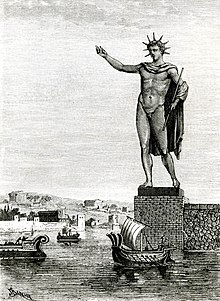
The island of Rhodes (Greek: Ρόδος) is the largest of the Dodecanese islands (Greek: Δωδεκάνησα) of Greece in the South Aegean. The township of Rhodes is also the capital city, the name coming from the ancient Greek ‘Rhodon’ (rose).
The island was inhabited from the Neolithic period, going back 12,000 years ago. The Minoans and Mycenaeans also occupied the island. Homer mentions that Rhodes participated in the Trojan War under the leadership of Tlepolemus. The Dorians in the 8th century BC built the three main cities of Lindos, Ialysos and Kameiros. In Pinda’s ode, the island is said to be born from the union of Helios the sun god or Apollo and the nymph Rhodos. Pinda states that when the gods met to draw lots for the places of the earth, Helios was absent and therefore did not receive anything. With Zeus’ consent, he claimed a new island (Rhodes), which had not as yet risen from the sea. With the union of Helios and Rhodos, seven sons were born.
During the Classical period, Rhodes joined the Athenian League. The Persians invaded the island, but were defeated by the Athenian forces in 478 BC. In 305, Demetrius, son of Antigonus, one of Alexander the Great’s generals, beseiged Rhodes for over a year. In the end, a peace treaty was signed, leaving behind a large store of military equipment. The Rhodians sold the equipment and used the money to erect the statue in honour of the Sun God Helios, who was also protector of the island.

The statue was erected by the sculptor, Chares of Lindos in 280 BC. The statue symbolised the freedom and independence of the people of the island. The base of the statue was of white marble and more than 15 tons of bronze and 9 tons of steel were used in its construction. It was estimated that it weighed 225 tonnes and stood 33 metres high, two and a half times higher than the statue of Zeus in ancient Olympia and approximately the same height as the Statue of Liberty today. It was the highest statue in the ancient world and was referred to as one of the Seven Wonders of the Ancient World.
The statue was considered Chare’s greatest accomplishment, until its destruction in an earthquake in 226 BC. According to an oracle, the Rhodians did not rebuild the statue as they were afraid that they had offended Helios. It lay on the ground until 653 AD when an Arab force captured Rhodes. The statue was melted down and sold to a Jewish merchant in Edessa, in Upper Mesopotamia. He loaded the bronze onto 900 camels.
Scholars agree that it would not have been possible for a statue that size to span the harbour. The actual location of the monument still remains a matter of debate. Some say that the Colossus of Rhodes was not located in the harbour area, but on the Acropolis of Rhodes, which stood on a hill that overlooks the port area.
The word colossus has become a part of the Greek, English and many Latin based languages to mean something large and impressive. Many sculptors throughout the ages have been inspired by the Colossus of Rhodes in their work. We therefore have the Colosseum of Rome built in Ancient Rome and the Statue of Liberty in the US today, which is considered to be a modern wonder.